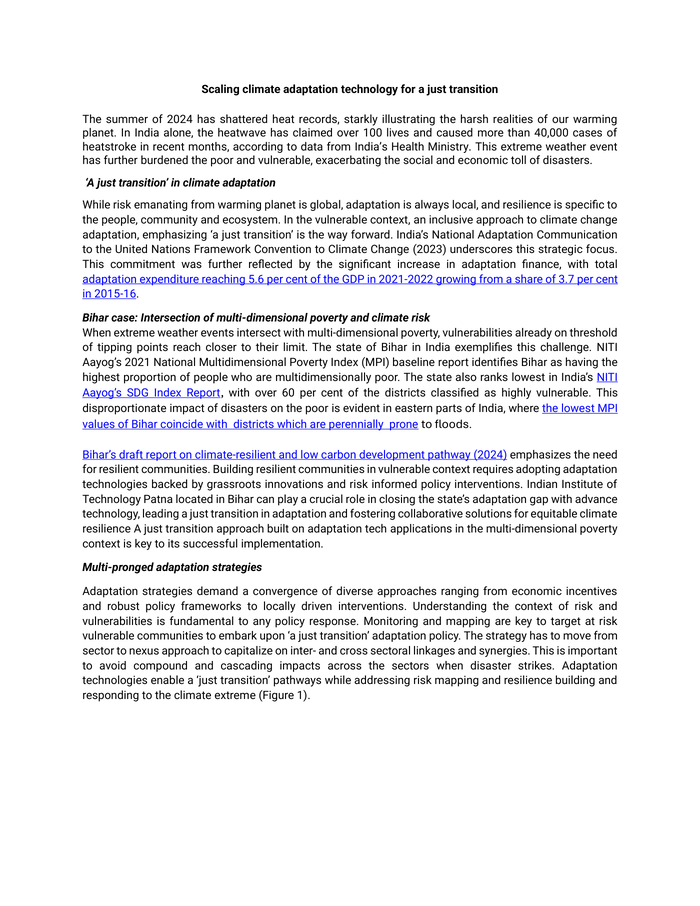The summer of 2024 will be the hottest on record, highlighting the harsh reality of global warming. In India alone, heatwaves have caused over 100 deaths and over 40,000 cases of heatstroke in recent months, according to data from the Indian Ministry of Health. This extreme weather puts an additional burden on the poor and vulnerable, exacerbating the social and economic toll of disasters.
A Just Transition on Climate Adaptation
While risks arising from global warming are global, adaptation is always local and resilience is specific to people, communities and ecosystems. In fragile contexts, a holistic approach to climate change adaptation that emphasizes a “just transition” is the way forward. India’s National Adaptation Communication to the UN Framework Convention on Climate Change (2023) highlights this strategic focus. This commitment is further reflected by a significant increase in adaptation finance, with total adaptation spending reaching 5.6% of GDP in 2021-2022 from 3.7% in 2015-16.
The case of Bihar: Intersection of multidimensional poverty and climate risks
When extreme weather events combine with multidimensional poverty, it pushes already tipping points of vulnerability even closer to the extreme. The Indian state of Bihar is a good example of this challenge. The National Institute of Indian Labour and Development Aayog’s (NITI Aayog) National Multidimensional Poverty Index (MPI) 2021 Baseline Report identifies Bihar as the state with the highest proportion of people living in multidimensional poverty. The state also ranks lowest in India’s NITI Aayog SDG Index report, with more than 60 percent of districts classified as highly vulnerable. This disproportionate impact of disasters on the poor is evident in eastern India, where the lowest MPI scores in Bihar coincide with districts prone to flooding every year.
The Draft Report on Bihar’s Climate Resilience and Low Carbon Development Pathways (2024) highlights the need for resilient communities. Building resilient communities in fragile contexts requires adopting adaptive technologies backed by grassroots innovation and risk-informed policy interventions. IIT Patna in Bihar can play a key role in bridging the state’s adaptation gap with advanced technologies, leading a just transition in adaptation and facilitating collaborative solutions for equitable climate resilience. A just transition approach based on adaptive technology applications in contexts of multidimensional poverty will be key to its success.
A multifaceted adaptation strategy
Adaptation strategies require a blend of approaches ranging from economic incentives and robust policy frameworks to locally led interventions. Understanding the risk and vulnerability landscape is fundamental to any policy response. Monitoring and mapping are key to targeting vulnerable communities at risk and embarking on “just transition” adaptation policies. Strategies need to move from a sectoral to a nexus approach to leverage inter- and cross-sector linkages and synergies. This is critical to avoid compounding and cascading impacts across sectors when disasters strike. Adaptation techniques address risk mapping and resilience building to address climate extremes while enabling “just transition” pathways (Figure 1).
Key driver: Adaptive Technology Cluster
Adaptation techniques consist of three clusters: (i) science-intensive, (ii) engineering-based, and (iii) data science and risk analytics (Figure 2). The challenge lies in customizing and extending in specific contexts of vulnerability. For example, ESCAP’s Risk and Resilience Portal integrates all three clusters and provides a unique capability to visualize current and future climate scenarios at baseline, 1.5 degrees, and 2 degrees. This foresight is essential to understand the evolving risks of floods, droughts, heat waves, and tropical cyclones, and enables predictive action for early warning against changing hazard conditions.
Opportunity for action: operationalizing the adaptation technologies cluster
India is operationalizing adaptation technologies at scale to support a “Just Transition” in fragile situations. The Mahatma Gandhi National Employment Guarantee Act (MNREGA), with an annual budget of $13 billion (2020), addresses location-specific adaptation priorities. Under MNREGA, assets related to water harvesting, drought relief, flood control activities, and sanitation will be created across the country. Satellite derived location services, with mobile-based geotagging, are being leveraged for planning and monitoring of around 7-8 million assets per year. An online geospatial map with over 30 million assets geotagged across all MGNREGA operations across the country has been a game changer.
The expansion of the adaptive technology cluster has helped in implementing social empowerment policies for the poor and vulnerable through a leak-free public delivery system. Over $406.9 billion has been transferred to 11.67 billion beneficiaries through JAM Trinity (Jan Dhan, Aadhaar and Mobile). Real-time monitoring through geotagging enhances transparency and financial inclusion of the poor and vulnerable through targeted policies.
schemes. Additionally, the startup ecosystem is helping scale up adaptation technologies. For instance, India is home to over 2,800 agritech startups driving innovation and transforming agriculture to adapt to climate risk conditions. From Internet of Things (IoT)-enabled farming practices to now AI-enabled machines and technologies, this burgeoning startup ecosystem holds great promise. It is important to seize the opportunity to advance innovation that benefits India’s most vulnerable. A dedicated centre for climate change adaptation technologies will be crucial to foster research, knowledge generation and capacity building in India’s most vulnerable contexts, with a focus on inclusivity and climate justice.
—
author:
- Sanjay Srivastava, Head of Disaster Risk Reduction Division, ESCAP
- Prof. TN Singh, Indian Institute of Technology (IIT), Patna, India
- Praveen Kumar, CEO (FIST-TBI), IIT Patna/India
- Naina Tanwar, Consultant, Disaster Risk Reduction Division, ESCAP
Related SDGs: SDG1, SDG2, SDG10, SDG13

